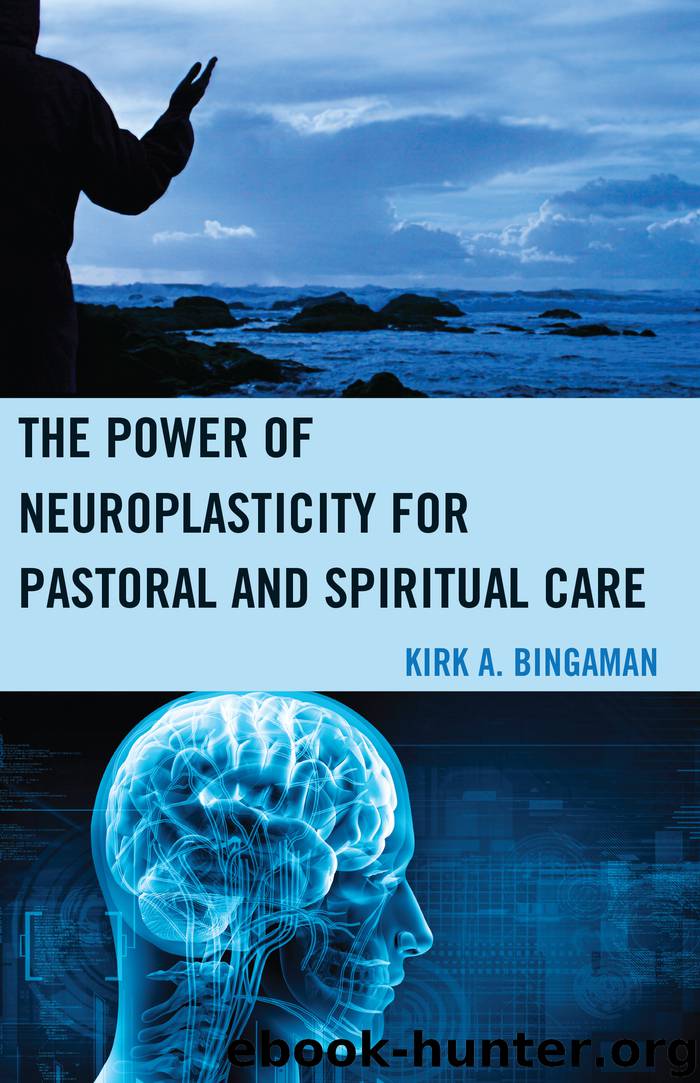The Power of Neuroplasticity for Pastoral and Spiritual Care by Bingaman Kirk A

Author:Bingaman, Kirk A.
Language: eng
Format: epub
Tags: undefined
Publisher: Lexington Books
Published: 2012-03-15T00:00:00+00:00
Cultivating Non-Judgmental Awareness
The third-party observation of our thoughts, feelings, and sensations during the practice of prayer and meditation, a sort of transcendent awareness of the totality of our experience, is a fundamental prerequisite to creating new connections and pathways in the brain. This harks back to Benson’s research on the relaxation response and his discovery that above all else the cultivation of a “passive attitude” vis-à-vis the totality of our experience is necessary for lowering stress and anxiety. During the practice of Centering Prayer and/or mindfulness meditation, for example, we do not judge our performance or how well we are doing, nor do we keep track of how often our mind wanders with distracting thoughts or feelings. If we are engaged in a twenty-minute Centering Prayer meditation, perhaps repeating the mantra of Jesus from the Sermon on the Mount (“Do not be anxious”), we will soon notice that anxious thoughts and feelings come to mind: What will I make for dinner? Am I prepared for today’s meeting? Did the kids do their homework? But rather than letting ourselves lose our meditational focus, either by indulging the distracting thought or fighting with it, we simply and gently bring our awareness back to the anchoring mantra without any need for critique. As Benson made clear, this meditational trajectory is “normal” for most of us; anxious and distracting thoughts are to be expected and do not mean that we are not getting it right or that we are less spiritual than the other person. The passive attitude that parallels Davidson’s third-party observation is a “let it happen” attitude of non-judgmental awareness, which for Benson and other researchers since him is the most important meditational element in calming the hyperactivity of the mind. As we develop and cultivate a daily spiritual practice, it is most important to remember that it is counterproductive to “worry about how well we are performing the technique, because this may well prevent the Relaxation Response from occurring” (Benson, 1975, p. 113).
In chapter one we learned from Newberg that the worst thing we can do in the context of daily prayer and meditation is to critically judge our performance, for the self-criticism will trigger amygdala-hippocampus reactions that in turn will release no shortage of stress-provoking neurochemicals. As Newberg puts it, it will not take long for any of us to discover in the quietude of our meditation that “there is a critical voice inside all of us that is constantly judging every little thing that we do” (2009, p. 195). Coming face to face with the so-called “inner critic” is therefore to be expected in any form of meditational practice, for it is perhaps the definitive internal manifestation of the brain’s negativity bias. “In meditation, as in therapy, we learn to watch our negativity and not react to it,” to be more “accepting of who we are, of our weaknesses as well as strengths” (Newberg, 2009, pp. 40 & 195). Moreover, as we learned from Siegel’s research, our efforts to
Download
This site does not store any files on its server. We only index and link to content provided by other sites. Please contact the content providers to delete copyright contents if any and email us, we'll remove relevant links or contents immediately.
When Breath Becomes Air by Paul Kalanithi(7280)
Why We Sleep: Unlocking the Power of Sleep and Dreams by Matthew Walker(5668)
Paper Towns by Green John(4179)
The Immortal Life of Henrietta Lacks by Rebecca Skloot(3835)
The Sports Rules Book by Human Kinetics(3602)
Dynamic Alignment Through Imagery by Eric Franklin(3505)
ACSM's Complete Guide to Fitness & Health by ACSM(3476)
Kaplan MCAT Organic Chemistry Review: Created for MCAT 2015 (Kaplan Test Prep) by Kaplan(3431)
Introduction to Kinesiology by Shirl J. Hoffman(3308)
Livewired by David Eagleman(3140)
The River of Consciousness by Oliver Sacks(3001)
Alchemy and Alchemists by C. J. S. Thompson(2918)
The Death of the Heart by Elizabeth Bowen(2912)
Descartes' Error by Antonio Damasio(2748)
Bad Pharma by Ben Goldacre(2738)
The Gene: An Intimate History by Siddhartha Mukherjee(2502)
Kaplan MCAT Behavioral Sciences Review: Created for MCAT 2015 (Kaplan Test Prep) by Kaplan(2495)
The Fate of Rome: Climate, Disease, and the End of an Empire (The Princeton History of the Ancient World) by Kyle Harper(2445)
The Emperor of All Maladies: A Biography of Cancer by Siddhartha Mukherjee(2440)
